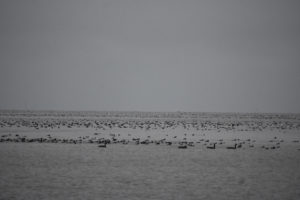
We are into that time of the year when many of our favorite songbirds have departed for warmer climes, but there is one group of birds that will still be traveling through the bay of Green Bay in flocks of thousands.
Waterfowl — diving ducks in particular — are arriving on the bay in incredible numbers and will continue to do so for at least another month.
Biologists divide ducks into two major groups: diving ducks and puddle ducks.
Divers
Diving ducks are built to dive underwater for long distances.
Their legs are set further back on their bodies, which allows for more efficient propulsion when diving.
Their wings are not as broad, and their bodies are a little more streamlined than puddle ducks.
Because their legs are so far back on their bodies, the divers are very poor walkers — not quite as bad as loons which have to just push themselves along on their bellies, but very inefficient.
Their wings are also narrower, so divers cannot erupt right off the water into flight; instead, they have to run along the surface for a while to build up speed to get airborne.
Divers eat a wide range of foods including fish, mussels, aquatic insects, crustaceans — such as shrimp and crayfish — and a variety of aquatic plants.
Common diving ducks in the Green Bay area include common, hooded and red-breasted mergansers, buffleheads, common goldeneyes, ring-necked ducks, greater and lesser scaup, redheads and canvasbacks.
The most specialized of the divers are the mergansers, which eat almost entirely fish.
Although no birds have teeth, the mergansers have tooth-like projections on their beaks which allow them to grab fish more effectively.
With a diet of mostly fish, mergansers are not a favorite in the kitchen.
A common joke among duck hunters goes like this: “Get a cedar plank and grill them on it, and when they get to medium rare, throw the merganser away and eat the plank.”
There are ways to make mergansers somewhat palatable, such as soaking them in salt water and grilling them rare, but about the nicest comment I could find on the internet is that if you do it just right, they don’t taste that awful.
Ironically, one species of diver, the canvasback, is considered an epicurean delight.
My father-in-law had an Oshkosh restaurant menu from back in the days when market hunting was legal and wild game was sold in restaurants.
Because of the canvasback’s reputation as the best tasting of all ducks, diners paid a premium for them.
Their excellent flavor comes from their diet of wild celery, a rooted aquatic plant that grows in shallow water and gives the flesh of the canvasback a delicate, celery-like taste.
Puddle ducks
Puddle ducks feed in shallow water, and rather than diving they just dip their heads beneath the surface in a motion known as dabbling.
When you see ducks with just their tails sticking straight up out of the water, those are feeding puddle ducks.
Common puddle ducks in this area are mallards, northern shovelers, wood ducks, gadwalls, American widgeon, pintails and blue- and green-winged teal.
Puddle ducks feed primarily on plants and because of this they are considered better eating than most of the divers.
Mallards in particular are considered highly desirable because of their large size and excellent taste.
The northern shoveler is an interesting duck to watch feed.
They do so in groups and use a technique where they swim in circles and stir up the muck on the bottom.
Their beak has comb-like structures called lamellae that are used to strain aquatic organisms out of the water.
I have observed groups of up to a dozen shovelers all swimming in a circle with their heads just under the surface while utilizing this feeding method.
Because much of the diet of shovelers is animal rather than plant, they are considered the least desirable of the puddle ducks for table fare.
Take in the show on the bay
The best place to observe large numbers of diving ducks is along the east shore of the bay.

During the peak of migration, tens of thousands of divers can be seen from Communiversity Park, but anyplace you can get down to the shore you will see ducks.
Diving ducks will gather into large mixed species flocks that are called rafts.
A large raft can have more than a thousand ducks.
The best time to observe the rafts is late afternoon going into the evening. Smaller flocks will circle the raft and then pile into the raft from one end or the other.
It is difficult to get close enough to the rafts of ducks to identify them with binoculars, but with a spotting scope you can sort them out.
Back in the market hunting days, gunners would use a shallow boat to sneak up on the rafts at night and then fire into the raft using a punt gun, which was essentially a small cannon.
They would frequently kill over 100 ducks with one shot.
Bay Beach Wildlife Sanctuary is a good place to see puddle ducks as well as some of the divers — including buffleheads — that don’t require larger bodies of water.
The Sanctuary is an excellent place to see American black ducks, a close relative of the mallard.
They are relatively rare in Wisconsin — we’re on the far western edge of black duck range — but for some reason they are quite common at the Sanctuary, possibly because they’re attracted to all of that corn people feed the ducks.
I suspect that most casual observers confuse the black ducks with hen mallards. Unlike the mallard, the drake and hen black duck are virtually identical.
The black duck has a purple speculum (the brightly colored patch on the wing) compared to blue on the mallard, and black ducks are a much darker shade of brown, almost black.
Sea ducks on the Big Pond
From late November through early March it is possible to observe sea ducks on Lake Michigan.
Sea ducks are species of divers that spend most of their time on oceans or very large lakes.
The best place I have found to observe sea ducks is Cave Point County Park, which is located in Door County just north of Whitefish Dunes State Park.
Among the species of ducks I have seen there in the winter are long-tailed ducks, white-winged scoters, red-breasted mergansers, goldeneyes, greater scaup and buffleheads.
To see a flock of long-tailed ducks in flight is a spectacularly beautiful sight.
They are sleek and fast and the entire flock flies in perfect synchrony.
It will take your breath away.
